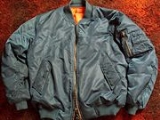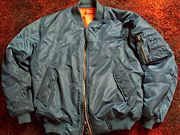
MA-1 bomber jacket
Encyclopedia
The MA-1 bomber jacket (also known as the MA-1 flight jacket) was first developed in the mid 1950s. The MA-1 and its predecessor, the B-15 Flight Jacket, were needed at that time because the emergence of the jet age created new requirements for pilot performance, safety and comfort.

-lined leather jackets were issued to flight personnel. However, the new jets could fly at much higher altitudes and in much colder temperatures than propeller aircraft. If the heavy, bulky leather jackets became wet from rain (when the pilot walked to his aircraft) or from perspiration, the water would freeze at high altitudes, making the jackets cold and uncomfortable. Also, the new jets were more streamlined in design. Cockpits were cramped and filled with new equipment. Speedy, unimpeded access to and exit from cockpits became even more critical for safety. Rather than bulky leather, a sleek, lightweight yet warm jacket was needed for the new jet technology.
To meet these needs, a new type of flight jacket was developed from the existing B-15 jacket, which was initially produced in cotton, but later produced in the same pattern but in high quality nylon. The B-15 had a wool collar with pile (a little like fur) carried over from the earlier B-10 that was found to interfere with straps in practice. Nylon
had been discovered prior to World War II but it was not used in flight clothing until after the war, possibly because the demand for nylon for items such as parachutes consumed the available supply during the war.
The first MA-1 jackets were issued around 1949 or 1950 to United States Air Force and Navy pilots and Flight crews. Small numbers were also issued to Army flight personnel. MA-1 jackets first appeared in Europe in very small quantities in the mid-to-late 1950s probably on the black market and at sales of government surplus. In the early to mid-1960s more MA-1 jackets appeared in Europe as Alpha Industries
began to export MA-1 jackets and other military clothing to European Air Forces and commercial customers.
The MA-1 has undergone various design modifications during its long history of use, but its classic, highly functional design has remained basically the same. The original design was contained in U.S. Government Military Specification "MIL-J-8279." Changes to the MA-1 jacket were periodically made by the Air Force. These occurred because of the introduction of new textiles, new sewing techniques or new aircraft cockpit design which required a change in the jacket design. The Military Specification was amended to reflect the changes, which was signaled by adding a letter to the Mil. Spec. For example, MA-1 specifications progressed from the original number Mil-J-8279, to J-8279A, J-8279B, J-8279C, etc. The most recent revision, J-8279F, was issued in the early 1980s.
The MA-1 was produced in two colors: sage green and midnight blue. Blue was the original color used by the military, but it was soon replaced by green. During the Korean War
, (1950–1953) mixing flight clothing from multiple time periods and colors was not unusual. Presumably, the green was eventually adopted because it blended more easily with the environment should the pilot need camouflage protection on the ground. Modern fashion MA-1's are available in a variety of colors, including the traditional ones and black, red, blue, silver, grey, yellow.
, often reimagined by clothes designers of the time.
The MA-1 is also in use in several police forces where cold weather is a part of everyday life. They were chosen over several other designs primarily for the sturdy construction, and the heavy insulation needed in extreme cold temperatures.

History
Prior to the invention of jet aircraft, fleeceWool
Wool is the textile fiber obtained from sheep and certain other animals, including cashmere from goats, mohair from goats, qiviut from muskoxen, vicuña, alpaca, camel from animals in the camel family, and angora from rabbits....
-lined leather jackets were issued to flight personnel. However, the new jets could fly at much higher altitudes and in much colder temperatures than propeller aircraft. If the heavy, bulky leather jackets became wet from rain (when the pilot walked to his aircraft) or from perspiration, the water would freeze at high altitudes, making the jackets cold and uncomfortable. Also, the new jets were more streamlined in design. Cockpits were cramped and filled with new equipment. Speedy, unimpeded access to and exit from cockpits became even more critical for safety. Rather than bulky leather, a sleek, lightweight yet warm jacket was needed for the new jet technology.
To meet these needs, a new type of flight jacket was developed from the existing B-15 jacket, which was initially produced in cotton, but later produced in the same pattern but in high quality nylon. The B-15 had a wool collar with pile (a little like fur) carried over from the earlier B-10 that was found to interfere with straps in practice. Nylon
Nylon
Nylon is a generic designation for a family of synthetic polymers known generically as polyamides, first produced on February 28, 1935, by Wallace Carothers at DuPont's research facility at the DuPont Experimental Station...
had been discovered prior to World War II but it was not used in flight clothing until after the war, possibly because the demand for nylon for items such as parachutes consumed the available supply during the war.
The first MA-1 jackets were issued around 1949 or 1950 to United States Air Force and Navy pilots and Flight crews. Small numbers were also issued to Army flight personnel. MA-1 jackets first appeared in Europe in very small quantities in the mid-to-late 1950s probably on the black market and at sales of government surplus. In the early to mid-1960s more MA-1 jackets appeared in Europe as Alpha Industries
Alpha Industries
Alpha Industries is an American clothing manufacturer founded in 1959 in Knoxville, Tennessee. Initially as a contractor to the United States military, the company grew into an international commercial seller of American military style and fashion apparel...
began to export MA-1 jackets and other military clothing to European Air Forces and commercial customers.
Characteristics
The MA-1 was designed by the Air Force to serve as an Intermediate Weight Flight Jacket for use all year. This was accomplished by manufacturing the MA-1 from very high quality nylon fabrics and polyester interlinings. The light weight nylon design allowed the pilot in warm weather to wear the jacket open and be comfortable; upon entering the aircraft, the pilot could zip the MA-1 closed and be afforded ample protection against the cold conditions encountered in flight.The MA-1 has undergone various design modifications during its long history of use, but its classic, highly functional design has remained basically the same. The original design was contained in U.S. Government Military Specification "MIL-J-8279." Changes to the MA-1 jacket were periodically made by the Air Force. These occurred because of the introduction of new textiles, new sewing techniques or new aircraft cockpit design which required a change in the jacket design. The Military Specification was amended to reflect the changes, which was signaled by adding a letter to the Mil. Spec. For example, MA-1 specifications progressed from the original number Mil-J-8279, to J-8279A, J-8279B, J-8279C, etc. The most recent revision, J-8279F, was issued in the early 1980s.
The MA-1 was produced in two colors: sage green and midnight blue. Blue was the original color used by the military, but it was soon replaced by green. During the Korean War
Korean War
The Korean War was a conventional war between South Korea, supported by the United Nations, and North Korea, supported by the People's Republic of China , with military material aid from the Soviet Union...
, (1950–1953) mixing flight clothing from multiple time periods and colors was not unusual. Presumably, the green was eventually adopted because it blended more easily with the environment should the pilot need camouflage protection on the ground. Modern fashion MA-1's are available in a variety of colors, including the traditional ones and black, red, blue, silver, grey, yellow.
Civilian use
Because the MA-1 Jacket not only keeps the wearer warm, but is highly comfortable, the jacket is very popular in Europe and Australia during winter. The jacket is also worn by many people in North America, where it is commonly known as a bomber jacket, especially in areas with cold weather. These jackets became popular in the late 1970s. During the 1980s the jackets had extensive exposure in style magazines such as The Face and I.D.I.D. (magazine)
I.D. was a magazine covering the art, business and culture of design. It was published eight times a year by F+W Media....
, often reimagined by clothes designers of the time.
The MA-1 is also in use in several police forces where cold weather is a part of everyday life. They were chosen over several other designs primarily for the sturdy construction, and the heavy insulation needed in extreme cold temperatures.

